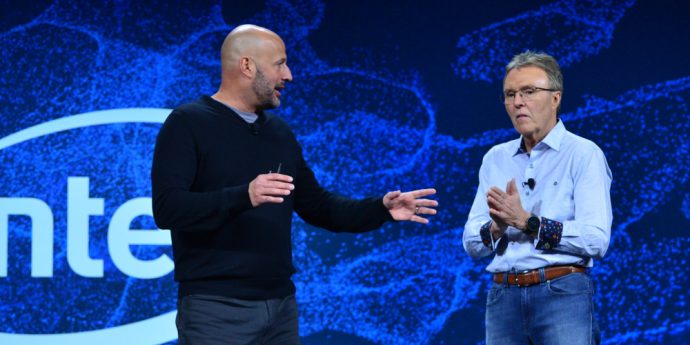
LAS VEGAS – Intel executives took to the stage at CES on Monday to showcase new chips that it boasts will unlock the promise of the connected home and advance artificial intelligence, 5G wireless and autonomous driving.
The chipmaker’s latest 5G and AI push is called Project Athena, an innovation program with new industry specifications for laptops.
Intel also showcased its latest Intel Xeon chips, shipping now, with advanced AI and memory capabilities, and ninth gen Intel Core desktop products. In addition it announced new 10nm (very tiny transistors) products for PCs, servers and 5G wireless access base stations.
Intel announced it’s also partnering with Comcast in a joint effort to enable gigabit and beyond broadband, enhancing wireless within the home and building a modern and adaptable infrastructure
“We are working together to lay the foundation for more powerful home networks and an intelligent network infrastructure that makes new immersive experiences possible,” said Gregory Bryant, Intel senior vice president and general manager of the client computing group, pictured above with Tony Werner, president of technology, product, experience at Comcast Cable, during Intel’s news event.
Intel estimates that each person in North America will have 13 or more connected devices by 2021, and demands are only increasing for high-resolution content streaming, gaming and more. The companies say their collaboration will deliver faster speeds, more capacity and responsive networks that will bring new immersive experiences to millions of people, including during the Olympic Games Tokyo 2020.
“With connectivity increasingly at the center of our homes and lives, we’re focusing on redefining what people should expect from broadband service, delivering world-class speed, comprehensive Wi-Fi coverage and unique tools for customers to control their digital lives,” said Werner. “Through our partnership with Intel, we’re not only delivering outstanding connected home experiences today, we’re building a platform to power the ultra-connected future.”
Delivering the benefits of Gigabit Wi-Fi speeds in the home requires both gigabit network speeds and PCs with 160 MHz technology says Intel. At CES 2019, Intel and Comcast are demonstrating how they can deliver gigabit speeds from Comcast’s xFi Advanced Gateways to PCs based on 8th Gen Intel Core processors with integrated Gigabit Wi-Fi. Intel claims users will soon realize the potential of Wi-Fi with up to 12 times faster connectivity speeds for faster sharing, streaming and downloading. The added speed makes it possible to smoothly stream 4K video.
Together, Intel and Comcast are also driving the adoption of Wi-Fi 6, the next generation standard that is built from the ground up to support a world that is hyper-connected over Wi-Fi.
In the future, homes with 50 or more devices and new life-changing technologies ranging from connected health to augmented reality will drive unprecedented demand for increased speed and capacity, says Intel. It’s now working with Comcast and other cable operators to develop a global standard for 10 Gigabit technology that will bring low-latency, multi-gigabit (up to 10 Gbps) performance and symmetrical upload and download speeds. Intel says it plans to deliver 10 Gigabit-ready technology from the network infrastructure to home gateways to support the rollout.
With 10 Gigabit technology Comcast hopes to offer:
- Sports and entertainment content: The distribution of cutting-edge immersive content across sports and entertainment, to deliver “viewing experiences like never before, starting with the Olympic Games Tokyo 2020.”
- VR gaming: A new tier of responsive virtual reality gaming experiences by optimizing the graphics processing between PCs and home gateway or network edge.
- Volumetric content: Using Intel RealSense technology and Intel Xeon processor-based servers, Comcast can cost-effectively capture, process and deliver volumetric content in real time for smaller scale implementations. For example training videos in order to make high-quality, three-dimensional video content accessible to a broader set of people.
- 360 video: With Intel based servers and graphics accelerators, Comcast will expand its rich media services and deliver more immersive content, such as streaming high-resolution 8K content.



